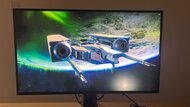The ASUS ROG Swift OLED PG27AQDM is a 27-inch, 1440p gaming monitor. Along with the Corsair XENEON 27QHD240, it's the main competitor to the LG 27GR95QE-B, as all three monitors use the same OLED panel with a 240Hz refresh rate. It features FreeSync variable refresh rate (VRR) support with G-SYNC compatibility, so it can reduce screen tearing with any type of graphics card. However, because it's limited to HDMI 2.0 bandwidth, HDMI 2.1 sources, like current-gen gaming consoles, can't make full use of the monitor. It's advertised to use heatsink technology that's supposed to make the screen brighter than other monitors with the same panel, and it has features to help reduce the risk of permanent burn-in, like pixel cleaning and screen move options.
Note: We originally tested this monitor with firmware MCM102, as we couldn't update to any of the newer firmware, MCM103 or MCM104. We tried four different PCs, with Windows 10 and 11, and couldn't update the firmware using the ASUS installer. We looked into why none of those PCs worked, but we couldn't find anything unusual. Other people have noticed this online, as you can read more about it here and here. This issue is caused by the firmware installer not working with certain PCs, but we couldn't find any common aspects about the configurations of the first four PCs we tried that would explain this problem. Because it's an issue related to the installer, we would have experienced the same thing even with another unit of this monitor.
Finally, we could update the firmware with a fifth PC, a basic desktop PC with Windows 11. However, on July 11, 2023, ASUS released an updated version of firmware MCM104 that you can install via USB. If you're having trouble updating the firmware with the installer, you can try updating it with a USB instead. The new firmware fixes issues with the HDR Brightness, HDR Color Gamut, and Input Lag, which we have retested.
Our Verdict
The ASUS PG27AQDM is excellent for most uses. Thanks to its high refresh rate, VRR support, and incredible motion handling, it's amazing for gaming. Its perfect black uniformity and near-infinite contrast ratio also make it fantastic for watching content in dark rooms, and it gets bright enough in HDR to make small highlights stand out. It's decent for office use and great for content creators as it has wide viewing angles, impressive ergonomics, and accurate colors, but it has some text clarity issues, and OLEDs are prone to burn-in.
-
Wide viewing angles.
-
Impressive ergonomics.
-
Near-instantaneous response time.
-
Near-infinite contrast ratio.
-
OLEDs are prone to burn-in.
-
Not bright enough for well-lit rooms.
-
Text clarity issues.
The ASUS ROG Swift PG27AQDM is decent for office use, but it's mainly limited by its issues with text clarity. Because computer operating systems don't render text well with the display's RWBG subpixel layout, text isn't as sharp as on other displays with the same pixel density. OLEDs are also prone to burn-in with constant exposure to the same static elements over time, like if you have a taskbar on the screen all day. It doesn't get bright enough to fight a ton of glare either, which is disappointing if you want to use it in a well-lit office, but it has fantastic reflection handling. It also has really wide viewing angles, which are useful if you constantly need to share the screen with someone else.
-
Fantastic reflection handling.
-
Wide viewing angles.
-
Impressive ergonomics.
-
OLEDs are prone to burn-in.
-
Not bright enough for well-lit rooms.
-
Text clarity issues.
The ASUS PG27AQDM is incredible for gaming. It has a near-instantaneous response time, resulting in smooth motion without any inverse ghosting or blur trail behind fast-moving objects. It also has VRR support to reduce screen tearing and a fast 240Hz refresh rate. It even has low input lag for a responsive feel, as long as the monitor is updated to the latest firmware. Lastly, it's great for dark room gaming as it displays perfect blacks, and there isn't any blooming around bright objects.
-
240Hz refresh rate with VRR support.
-
Near-instantaneous response time.
-
Near-infinite contrast ratio.
-
Perfect black uniformity.
-
OLEDs are prone to burn-in.
-
Limited to HDMI 2.0 bandwidth.
The ASUS PG27AQDM is fantastic for media consumption. Its OLED panel displays deep and inky blacks without any blooming around bright objects, making it an ideal choice for watching content in dark rooms. However, it doesn't perform so well in bright rooms because of its low peak brightness. Luckily, it's easy to share the screen with someone as its impressive ergonomics make it easy to adjust, and its wide viewing angles ensure that your friend sitting next to you sees a consistent image from the sides.
-
Wide viewing angles.
-
Near-infinite contrast ratio.
-
Perfect black uniformity.
-
Amazing image accuracy.
-
Aggressive ABL in HDR.
The ASUS PG27AQDM is great for content creators but has some limitations. It has amazing accuracy in its sRGB mode, so you may not need to get it calibrated, and it also displays a wide range of colors. The impressive ergonomics and wide viewing angles are also ideal if you constantly need to share the screen with someone else. However, it has text clarity issues caused by its subpixel layout, so text elements in your editing programs don't look sharp. OLEDs like this one are also prone to burn-in with constant exposure to the same static elements over time, like if you work with the same editing program open all day.
-
Fantastic reflection handling.
-
Wide viewing angles.
-
Impressive ergonomics.
-
Amazing image accuracy.
-
OLEDs are prone to burn-in.
-
Not bright enough for well-lit rooms.
-
Text clarity issues.
The ASUS ROG Swift PG27AQDM is incredible for HDR, but you must update it to the latest firmware for the best performance. It displays deep blacks and has perfect black uniformity, meaning it performs extremely well in dark rooms. It displays a wide range of colors in HDR and has good peak brightness, enough to make small highlights stand out against the rest of the image. However, it also has an aggressive ABL, so large highlights are dimmer, and the changes in brightness can be distracting.
-
Near-infinite contrast ratio.
-
Perfect black uniformity.
-
Bright enough for small highlights to pop.
-
Good EOTF tracking.
-
Red tint issues in HDR with original firmware and default Color Temp setting.
-
Aggressive ABL in HDR.
- 8.8 Mixed Usage
- 8.1 Office
- 9.1 Gaming
- 9.2 Media Consumption
- 8.9 Media Creation
- 9.2 HDR
- Updated Aug 21, 2023: Added in the Intro that the Corsair XENEON 27QHD240 is one of this monitor's main competitors.
- Updated Jul 28, 2023: Added that the Corsair XENEON FLEX 45WQHD240 is a bigger alternative with a 45-inch OLED screen in Resolution and Size.
- Updated Jul 24, 2023: Retested the Input Lag with VRR enabled, which improves the input lag. Also corrected an error that said the monitor has built-in speakers.
- Updated Jul 12, 2023: Updated the firmware to MCM104 and retested the HDR Brightness, HDR Color Gamut, and Input Lag. The firmware update significantly improves the performance in those areas, and the entire review has been updated to reflect those changes.
- Updated Jul 05, 2023: We added links to examples of people experiencing the same issue as us when trying to update the firmware in HDR Brightness, HDR Color Gamut, and Input Lag.
- Updated Jul 04, 2023: Review published.
- Updated Jun 28, 2023: Early access published.
- Updated Jun 16, 2023: Our testers have started testing this product.
- Updated Jun 09, 2023: The product has arrived in our lab, and our testers will start evaluating it soon.
- Updated May 03, 2023: We've purchased the product and are waiting for it to arrive in our lab.
Check Price
Differences Between Sizes And Variants
We tested the 27-inch ASUS ROG Swift OLED PG27AQDM, the only size available for this monitor.
| Model | Size | Panel Type | Resolution | Max Refresh Rate |
|---|---|---|---|---|
| PG27AQDM | 27" | OLED | 1440p | 240Hz |
Our unit was manufactured in Feb 2023; you can see the label here. These results are with firmware MCM104, as there are some HDR issues with firmware MCM102, so if you experience issues in HDR, try updating to the latest firmware.
Compared To Other Monitors
The ASUS PG27AQDM is an excellent monitor that combines a fast 240Hz refresh rate with an OLED panel, making it a great choice for gamers who crave high refresh rates and good picture quality. There are known HDR issues with its original firmware, but as long as you can update it to its latest firmware, it's a nice upgrade over the LG 27GR95QE-B, which uses the same panel, but the ASUS gets much brighter in HDR and has less overshoot. However, it has a more aggressive ABL than the LG, so there are some distracting changes in brightness in HDR content, even while gaming. Of course, it doesn't deliver the same vivid colors as QD-OLEDs like the Dell Alienware AW3423DWF, but if you want a 27-inch monitor with a high refresh rate over an ultrawide display, you should be happy with this one.
See our recommendations for the best 240Hz monitors, the best 27-inch monitors, and the best 1440p gaming monitors.
The LG 27GR95QE-B and the ASUS ROG Swift OLED PG27AQDM use the same panel, but there are some differences in performance. The ASUS gets much brighter in HDR, making smaller highlights pop more, but you also need to make sure to update it to the latest firmware to get the best HDR performance. The ASUS also has an advantage with motion handling as it has less overshoot. One area where the LG has an advantage is that it has HDMI 2.1 bandwidth, letting it take full advantage of gaming consoles and high-end graphics cards. The LG also has a less aggressive ABL, so there aren't as many distracting changes in brightness in HDR.
Despite sharing similar names, the ASUS ROG Swift OLED PG27AQDM and the ASUS ROG Swift 360Hz PG27AQN are different types of monitors. The PG27AQDM has an OLED panel that results in deeper blacks and less blooming, and it also has better motion handling at lower refresh rates. On the other hand, the PG27AQN has a higher 360Hz refresh rate, making it a better choice for competitive gaming. It also gets brighter, has better text clarity, and doesn't risk permanent burn-in like on the PG27AQDM.
The Corsair XENEON 27QHD240 and the ASUS ROG Swift OLED PG27AQDM use the same panel, but there are a few differences. The ASUS gets much brighter, especially in HDR, and colors look more vivid thanks to its improved color volume, so its overall picture quality is better. However, the Corsair has a few extra features that the ASUS doesn't have, like HDMI 2.1 bandwidth, USB-C ports, and a KVM switch. These can be useful if you want to connect multiple devices.
The Dell Alienware AW3423DWF and the ASUS ROG Swift OLED PG27AQDM are different types of OLED displays. The Dell is an ultrawide monitor with a larger screen, and it uses extra quantum dot technology to display a wider range of colors that are brighter and more vivid than on the ASUS. However, the ASUS still gets brighter, so small highlights pop more. The ASUS also has a higher 240Hz refresh rate, which makes it ideal for competitive gamers.
The Samsung Odyssey OLED G8/G85SB S34BG85 and the ASUS ROG Swift OLED PG27AQDM are different types of OLED displays. The Samsung is an ultrawide monitor with a larger screen, and it uses extra quantum dot technology to display a wider range of colors that are brighter and more vivid than on the ASUS. The Samsung also has a built-in smart system, making it easier to stream your favorite content without the need for a PC. The ASUS also gets brighter in HDR, so small highlights pop more. The ASUS also has a higher 240Hz refresh rate, which makes it ideal for competitive gamers.
The Dell Alienware AW3423DW and the ASUS ROG Swift OLED PG27AQDM are different types of OLED displays. The Dell is an ultrawide monitor with a larger screen, and it uses extra quantum dot technology to display a wider range of colors that are brighter and more vivid than on the ASUS. However, the ASUS still gets brighter, so small highlights pop more. The ASUS also has a higher 240Hz refresh rate, which makes it ideal for competitive gamers.
Test Results
The ASUS PG27AQDM has a gamer-oriented design with thin bezels and a tripod stand. It features RGB lighting in the form of Republic of Gamers (ROG) logos with a down-facing light on the stand, and it comes with extra covers so that you can change the design of the light. There's more lighting on the back too.
The build quality is excellent. The housing of the display is plastic which feels sturdy, and there aren't any obvious issues with how it's put together. The bezels are properly attached to the screen throughout, as you can see here. The metal stand is also solid as it holds the screen well, and even the feet are grippy, so it doesn't easily slide on the desk. The one downside is that the bottom piece for the RGB lighting can come off if you're holding it there and you aren't careful, but it's meant to come off anyways.
The ASUS PG27AQDM has impressive ergonomics; you can adjust it in several ways. The stand also offers cable management, but because the inputs are down-facing, they can be hard to reach at times. The back of the monitor features robust housing for the inputs, but the panel itself is thin. There are also vents on the housing, as you can see here. It comes with a mounting bracket if you want to mount the monitor.
The tripod stand holds the screen well, and because the feet are grippy, it doesn't easily slide on the desk. However, this can also be a downside, as you would need to lift the entire monitor to move it.
- DisplayPort cable
- HDMI cable
- Power supply and cable
- USB-B to USB-A cable
- Mounting bracket (100x100)
- Down-facing light accessories
- Accessories bag
- ROG sticker set (see here)
- User documentation, including calibration report
OLED panels like this one don't have a backlight, so they don't require a local dimming feature. However, with a near-infinite contrast ratio, there isn't any blooming around bright objects, and it's the equivalent of a perfect local dimming feature. We still film these videos on the monitor so you can see how the screen performs and compare it with a monitor that has local dimming.
The ASUS PG27AQDM has okay SDR brightness but isn't nearly as bright as the advertised 450 cd/m². While it's brighter than the LG 27GR95QE-B, it still isn't bright enough to fight glare in a very bright room, so visibility can be an issue. These results are from after calibration in 'User Mode' GameVisual, which is the name for the picture mode, with the Brightness at its max and Uniform Brightness disabled. This setting helps reduce the Automatic Brightness Limiter (ABL), but it also keeps the brightness the same across different scenes, and the screen is dimmer, which you can see here:
- Real Scene 149 cd/m²
- Peak 2% Window 148 cd/m²
- Peak 10% Window 151 cd/m²
- Peak 25% Window 152 cd/m²
- Peak 50% Window 152 cd/m²
- Peak 100% Window 152 cd/m²
- Sustained 2% Window 141 cd/m²
- Sustained 10% Window 150 cd/m²
- Sustained 25% Window 151 cd/m²
- Sustained 50% Window 152 cd/m²
- Sustained 100% Window 152 cd/m²
- ABL 0.002
- Minimum Brightness 13 cd/m²
The ASUS PG27AQDM has good HDR brightness with firmware MCM104. These results are in 'ASUS Gaming HDR' HDR Setting with Adjustable Brightness off, Brightness locked to its max, and the Color Temp set to '6500K'. There's an issue with setting Color Temp to its default of '8200K' that results in an orange tint and a much dimmer image. This is what we noticed when we originally tested it on firmware MCM102, but after updating the firmware to MCM104 and changing Color Temp to '6500K', the monitor gets much brighter. It's also important to note that if you plug in a new source for the first time and switch inputs, Color Temp defaults back to '8200K', so you need to change it back to '6500K', but the monitor will save that setting for the next time you switch to that input.
The firmware update allows small highlights to get extremely bright, but there's an aggressive ABL that causes large highlights to be very dim, and the changes in brightness can be noticeable even while gaming. The update also fixes the EOTF, as it follows the target PQ curve perfectly until there's a sharp cut-off at the peak brightness, meaning it gets the brightest it can before letting your PC do any tone mapping.
Unlike in SDR, there's a setting in HDR called Adjustable Brightness that lets you change the Brightness setting if you want something with less aggressive ABL, but it also makes the screen dimmer. When enabling this setting and leaving the Brightness at its max, the brightness of the display is the same as leaving Adjustable Brightness off.
While the manufacturer advertises this monitor as using heatsink technology, it doesn't dissipate heat well. As you can see here, heat is concentrated towards the bottom. For reference, you can also see what the LG 27GR95QE-B looks like here, and on this monitor, heat is concentrated more towards the center.
The ASUS ROG Swift OLED PG27AQDM has a fantastic horizontal viewing angle. While it isn't perfect, you won't notice any inconsistencies when viewing from the sides, making this a great choice for co-op gaming.
The vertical viewing angle is remarkable. The image looks the same even if you're standing up and looking down on it or have it mounted above eye level.
The accuracy in the sRGB mode before calibration is amazing. The sRGB mode locks colors well to the sRGB color space, and even the white balance and color temperature are great. However, gamma is off as it seems to follow a 2.0 target instead of sRGB, meaning most scenes are too bright. Unfortunately, using the sRGB mode disables many settings, including Uniform Brightness, so there's a somewhat aggressive ABL that causes full-screen windows to be dimmer than smaller windows. If you do want to use those locked-out settings, the 'User Mode' has a similar color temperature and white balance, but colors are oversaturated, and gamma is the same, as you can see here.
The accuracy after calibration is amazing. Even though calibrating it only slightly improves the color accuracy, white balance, and color temperature, it fixes gamma a lot more. Also, by calibrating it, you can adjust settings that are locked out in the sRGB mode, like Uniform Brightness.
The SDR color gamut is fantastic. It has near-perfect coverage of the sRGB color space used in most web content. It's also excellent with the Adobe RGB color space used in some professional content creation, but it oversaturates reds and undersaturates greens.
The ASUS PG27AQDM has a fantastic color gamut. With firmware MCM104 and Color Temp set to '6500K', it displays colors accurately, and there aren't any obvious issues. Before the update, there was a red tint issue with firmware MCM102 as the monitor didn't tone map well, and even after updating to MCM104, we still noticed the same issue with Color Temp set to its default of '8200K'. It has worse tone mapping as you can see with the DCI-P3 gamut here, and Rec. 2020 here. Switching Color Temp to '6500K' results in the best performance, and even if you change it back to '8200K', you get a cold temperature, but it doesn't have the same red tint as it originally had. You can also see examples below of what the monitor looks like with the two Color Temp settings, including the red tint issue with '8200K', compared to the LG 27GR95QE-B in Destiny 2:
| ASUS - Color Temp 8200K | ASUS - Color Temp 6500K | LG |
 |  |  |
 |  |  |
 |  |  |
 |  |  |
The HDR color volume is great. It displays bright and dark colors well, but its incomplete color gamut limits it, and it doesn't display colors as bright as on QD-OLEDs like the Dell Alienware AW3423DWF. Although updating it to firmware MCM104 and changing the Color Temp to '6500K' doesn't significantly increase the color volume compared to firmware MCM102 with Color Temp set to '8200K', the tone mapping and overall image looks better with the latest firmware.
The reflection handling is fantastic. It has the same aggressive matte coating as the LG 27GR95QE-B, so it reduces glare well, but that also introduces haziness to images. Despite this fantastic reflection handling, visibility can still be a problem in bright rooms due to its low peak brightness.
The text clarity is okay, but it's worse than LED-backlit LCD monitors because computer programs don't render text well with its RWBG subpixel layout. As you can see, with Windows ClearType enabled (top photo), there's color fringing, so if that bothers you, you'd have to disable ClearType. The same issue exists with Windows 11, as you can see with ClearType on and with ClearType off. On top of its text rendering issues, the aggressive matte coating makes text look hazy.
Due to the RWBG subpixel layout, all four pixels are never on simultaneously. You can see additional photos of the pixels on the LG 27GR95QE-B below, as it uses the same panel:
You can reach the ASUS PG27AQDM's max refresh rate over DisplayPort, and to reach 10-bit signals, your graphics card needs to support Display Stream Compression (DSC), which any NVIDIA 16 Series or AMD RX 5000 Series and newer graphics card supports. Sadly, you can't reach its max refresh rate over HDMI because it's limited to HDMI 2.0 bandwidth.
The ASUS PG27AQDM's variable refresh rate support works both with FreeSync and G-SYNC over HDMI and DisplayPort, and there aren't any issues. It uses Low Framerate Compensation to help the VRR continue working despite low frame rates.
| Overdrive Setting | Response Time Chart | Response Time Tables | Motion Blur Photo |
| VRR On | Chart | Table | Photo |
The response time at 60Hz is fantastic. While some dark transitions are slower than at higher refresh rates, there isn't any visible overshoot that causes inverse ghosting like on the LG 27GR95QE-B.
The ASUS PG27AQDM doesn't have an optional black frame insertion feature to reduce persistence blur.
The ASUS ROG Swift OLED PG27AQDM technically isn't flicker-free because there's a slight dip in brightness that corresponds to the 240Hz refresh rate. However, it isn't the same as pulse width modulation because it isn't a full screen on and off, and you won't notice this flicker.
The ASUS PG27AQDM has low input lag for a responsive feel with firmware MCM104. The input lag is lowest with VRR enabled, which is what we tested it with. The input lag is a bit higher with a fixed signal, as you can see here:
- Native Resolution @ Max Hz: 2.8 ms
- Native Resolution @ 120Hz: 6.9 ms
- Native Resolution @ 60Hz: 15.1 ms
Additionally, these results are with firmware MCM104, as the input lag is much higher at 120Hz and 60Hz with firmware MCM102, which is something other people have reported online, as you can read here. These are the results with firmware MCM102:
- Native Resolution @ Max Hz: 8.8 ms
- Native Resolution @ 120Hz: 16.7 ms
- Native Resolution @ 60Hz: 33.6 ms
The 27-inch screen may seem small to some, so if you want something bigger with an OLED panel, you can also consider the Corsair XENEON FLEX 45WQHD240, but it has a lower pixel density.
The ASUS ROG Swift OLED PG27AQDM works as expected with the PS5, but because it doesn't support HDMI 2.1 bandwidth, it doesn't support 4k @ 120Hz. For VRR to be actively working on the monitor, you may need to go into a game first.
The ASUS PG27AQDM works well with the Xbox Series X|S, but without HDMI 2.1 bandwidth, it doesn't support 4k @ 120Hz signals. It still downscales a 4k image, and you don't need to use the HDMI override for 1440p signals, meaning VRR works simultaneously with 1440p.
You need to connect the USB-B to USB-A cable to your computer for the USB ports to work.
The ASUS ROG Swift OLED PG27AQDM is compatible with macOS, but there are some issues. You can only get a 60Hz or 120Hz refresh rate over HDMI as VRR doesn't work at all, and if you're using a MacBook, windows return to their original position after closing and reopening the lid or when putting the MacBook to sleep.
It supports VRR when using a DisplayPort to USB-C cable, but it doesn't properly connect at first. The first time we connected it, we had to change DisplayPort Stream from '1.4' to '1.2' for it to work, then the second time we connected it, we had to unplug and replug the cable, and set DisplayPort Stream back to '1.4' for it to work.
The ASUS PG27AQDM has a few extra features, including:
- Aspect Control: You can change the aspect ratio of the image to its original size, a 1:1 ratio, or 16:9, but with a 25-inch screen size.
- Aura RGB: Controls the RGB lighting on the back of the monitor and on the stand.
- Blue Light Filter: Removes blue light to help reduce eye strain.
- GamePlus: Includes different gaming features like an FPS counter, crosshairs, sniper mode, stopwatch, and timer.
- Shadow Boost: Adjusts gamma so that you can see opponents better in dark scenes.
- Power Saving Mode: Limits the power consumption but also disables many settings.
While the settings menu has options to adjust the volume and mute, it's for external speakers, as the monitor itself doesn't have any speakers.
Like most OLED displays, there are also a few settings to help reduce the risk of burn-in, which you can find in the Screen Protection section of the OSD:
- Adjust Logo Brightness: Dims static logos that are on the screen, like if you're watching TV.
- Pixel Cleaning: This feature corrects any individual pixels that may be broken. It happens after you turn off the screen and takes about six minutes to finish. There's also a setting to remind you to turn off the monitor so it can perform the cycle.
- Screen Move: Moves the image by a few pixels to one side to help reduce the risk of burn-in.
- Screen Saver: Automatically dims the screen when there's inactivity.
Burn-in can occur with constant exposure to the same static elements over time, so the best ways to reduce the risk of burn-in is by watching varied content, hiding the taskbar, using a black background, and taking advantage of these settings. You can learn about our current longevity and burn-in test here.




















































